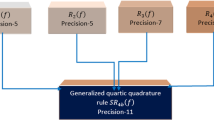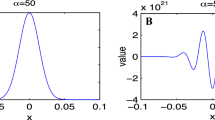Abstract
The paper focusses on the advantages of using high-order Gauss–Legendre quadratures for the precise evaluation of integrals with both smooth and rapidly changing integrands. Aspects of their precision are analysed in the light of Gauss’ error formula. Some “test examples” are considered and evaluated in multiple precision to \(\approx \)200 significant decimal digits with David Bailey’s multiprecision package to eliminate truncation/rounding errors. The increase of precision on doubling the number of subintervals is analysed, the relevant quadrature attribute being the precision increment. In order to exemplify the advantages that high-order quadrature afford, the technique is then used to evaluate several plots of the Rayleigh–Sommerfeld diffraction integral for axi-symmetric source fields defined on a planar aperture. A comparison of the high-order quadrature method against various FFT-based methods is finally given.







Similar content being viewed by others
Notes
The corresponding author can e-mail files of high-order (\(N\le 200\)) Gauss–Legendre weights and abscissae evaluated to 200 significant decimals to any programmer wishing to repeat our computations
References
D.H. Bailey, A portable high performance multiprecision package. NASA RNR Technical, Report (RNR-90-022) (1993)
D.H. Bailey, Multiprecision translation and execution of fortran programs. ACM Trans. Math. Softw. 19, 288–319 (1993)
P.J. Davis, P. Rabinowitz, Methods of Numerical Integration (Academic Press, New York, 1975) pp. 96–99
C.N. Pannell, W.A.B. Evans, D.A. Jackson, A new integration technique for flowmeters with chordal paths. Flow. Meas. Instrum. 1, 216–224 (1990)
C.G. Harris, W.A.B. Evans, Extension of numerical quadrature formulae to cater for end point singular behaviours over finite intervals. Int. J. Comput. Math. B6, 219–227 (1977)
C. Huygens, Trait’e de la lumi‘ere, Published in Leyden (1690)
M. Born, E. Wolf, Principles of Optics (Cambridge U.P., New York, 1999)
J.D. Jackson, Classical Electrodynamics, 3rd edn. (Wiley, New York, 1998)
J.W. Goodman, Introduction to Fourier Optics (McGraw Hill, New York, 1996)
B.B. Baker, E.T. Copson, The Mathematical Theory of Huygens’ Principle (Clarendon Press, Oxford, 1939)
E.T. Copson, Proc. Roy. Soc. (London), Series A, 186, 100 (1946).
R.K. Luneburg, Mathematical Theory of Optics (University of California Press, Berkeley, 1964)
A. Sommerfeld, Zur mathematischen theorie der beugungsercheinungen. Nachr. Kgl. Acad. Wiss. Göttingen 4, 338–342 (1894)
A. Sommerfeld, Optics (Academic Press, New York, 1949), p. 201. Translated by O. Laporte and P.A. Moldauer
Lord Rayleigh, On the passage of waves through apertures in plane screens, and allied problems. Philos. Mag. 43, 259–272 (1897)
G.R. Kirchoff, Zur theorie der lichtstrahlen. Ann. Phys. (Leipzig) 18, 663–695 (1883)
G.B. Airy, On the diffraction of an object glass with circular aperture. Trans. Camb. Phil. Soc 5, 283 (1835)
T.M. Pritchett, Spectral Solution of the Helmholtz and Paraxial Wave Equations and Classical Diffraction Formulae. Army Research, Report (ARL-TR-3179), pp. 1–19 (2004)
G.D. Gillen, S. Guha, Modelling and propagation of near-field patterns: a more complete approach. Am. J. Phys. 72, 31195–31201 (2004)
J.A.C. Veerman, J.J. Rusch, H.P. Urbach, Calculation of the Rayleigh-Sommerfeld diffraction integral by exact integration of the fast oscillating factor. J. Opt. Soc. A 22, 636–646 (2005)
F. Shen, A. Wang, Fast-Fourier-transform based numerical integration method for the Rayleigh-Sommerfeld diffraction formula. Appl. Opt. 45, 1102–1110 (2006)
K. Atkinson, Elementary Numerical Analysis (Wiley, New York, 1985)
B. Basden, R.R. Lucchese, High order Newton-Cotes integration methods in scattering theory. J. Comput. Phys. 77, 524–536 (1988)
S. Karlin, W.J. Studden, Tchebycheff Systems with Applications in Analysis and Statistics (Wiley, New York, 1966)
Acknowledgments
WABE is indebted to Prof. Mainardi for alerting him to David Bailey’s multi-precision package, MPFUN, and acknowledges some useful past discussions on quadrature topics with Prof. A.C. Genz and the late Prof. P. Rabinowitz. AT thanks Dr. Omar El Gawhary for interesting discussions on paraxial propagation-related issues. The authors also convey their thanks to an anonymous referee whose comments and suggestions have indubitably improved the paper.
Author information
Authors and Affiliations
Corresponding author
Appendix: High-order quadrature program
Appendix: High-order quadrature program
The FORTRAN program used to evaluate the integrals is listed below. The high-order Gauss–Legendre weights and abscissae are read from data-statements in the cquad subroutine or, as here, read from a file in the main program and put in the wtsabs common block that is shared with cquad.


Note that it basically evaluates the integral, \(\int_{x\rm {min}}^{x\rm{max}} \hbox{fun}(x)\,\hbox{d}x\), over M equal subintervals using weights and abscissae that are “read-in” from a file by the calling program and made available to the cquad subroutine via the common block, wtsabs.Footnote 1
To evaluate the R–S integral, which is 2-dimensional, the integrand function, \(fun1(\user2{r}_{\mathbf{0}},r,\theta )\), in general, depends on \(\theta \) and must be integrated numerically over this polar angle (and including any \(\theta \)-dependence in \(u(r,\theta \))). This gives a result, \(fun(\user2{r}_0,r)\), which is then integrated over the radial distance, \(0\le r\le \infty \) and so cover the whole aperture plane as shown schematically in (36).
Here the programmer is alerted to the fact that, if the same quadrature is used for both the \(\theta \)- and \(r\)-integrations, then it is recursively called. Most modern compilers will recognise this and take appropriate action, but there are some compilers that do not—and accordingly produce “non-sensical” output as all of both quadrature evaluations were done in the same quadrature ‘memory space’. In such cases the solution is to compile two cquad quadrature subroutines, differing only in their calling names, and to call them appropriately in the calling program(s). This forces the compilation of a distinct subroutine for each quadrature.

Rights and permissions
About this article
Cite this article
Evans, W.A.B., Torre, A. On numerical integration with high-order quadratures: with application to the Rayleigh–Sommerfeld integral. Appl. Phys. B 109, 295–309 (2012). https://doi.org/10.1007/s00340-012-5128-0
Received:
Revised:
Published:
Issue Date:
DOI: https://doi.org/10.1007/s00340-012-5128-0




